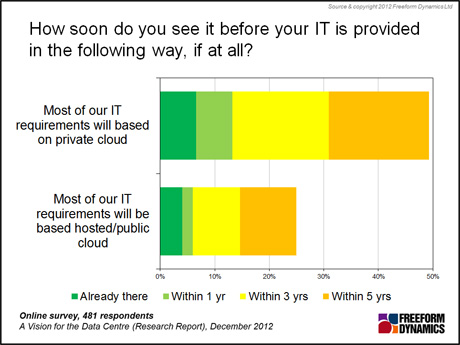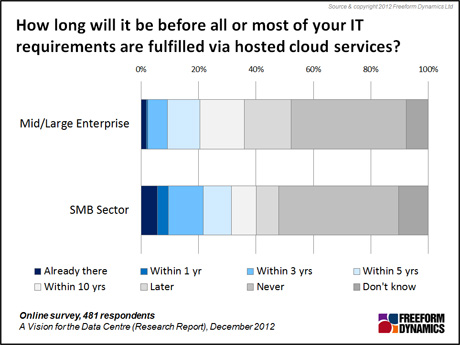By Andrew Buss
A few weeks back we looked at the role that private and public cloud services play both today and in the future.
We saw that most companies are keen to keep their IT in house, but to optimise it to be much more dynamic, orchestrated and automated through moving to private cloud architectures and operations (Figure 1).

Figure 1
These companies tend to view public cloud services as a tactical play on the whole, making use of them when needed but not moving their existing workloads out of their environment en-masse.
But this still leaves a significant minority of companies that do think that they’ll be willing and able to run IT mainly using public cloud or third party hosted services.
As SMBs are generally smaller and with quick and centralised decision making it is no surprise to see that they are the most inclined to adopt and use public cloud to deliver the majority of their IT. Even here though, the figure is still low overall at around one in five seeing this as happening within 3 years (Figure 2).

Figure 2
While it is a positive sign for public cloud providers that SMBs seem to have a reasonable appetite for their services, things are not all that simple. Despite a strong initial uptake, around 70% think that it will take a long time or never happen at all.
From previous as well as on-going research, we can identify certain areas that, if addressed, can make things simpler and more attractive for small businesses to grow up using public cloud services. We informally call the delivery of IT services without using internal resources, servers, storage, applications etc., ’the infrastructureless office’.
Companies today typically need to buy many applications to cater for their back-office as well as productivity and collaboration needs. These have traditionally been licenced from a range of discrete software vendors such as Microsoft, Sage, Intuit or Adobe. The market for public cloud services is typically arranged along similar lines, where different services may be bought from a number of separate providers. These may include those listed above, or from providers that are solely cloud based such as SalesForce.com.
This results in the ‘tyranny of choice’ syndrome, where the decision maker can be overwhelmed by the range on offer. It can be really hard to nail down what service does the job effectively, and can easily dissuade the decision maker from proceeding.
This is an area where cloud providers or local integrators and resellers can try and simplify things for the SMB market, by providing a suite of pre-integrated application services targeted for explicit verticals or country specific conditions. The advantage is that additional services can be added to a subscription quickly and easily, with a minimum of integration by the customer and with a single billing relationship.
It may have been difficult, if not impossible, for a single software vendor offering on-premises software, to pull together the range of software that small business want or need. But a service provider or delivery partner can work across multiple software vendors to do the pre-selection and integration required to for a ‘cloud suite’.
Another problem that many SMBs face is that there are few people around with time available to trial or optimise things, and many are not dedicated to IT. Often at times, IT decisions are made by business people who have to juggle priorities and whose attention is not really focused on IT. In order to use public cloud services, they need the transition from what they currently use to a cloud offering to be quick and painless. In many cases though, cloud service providers do themselves no favours by not having automated import or setup tools.
This may sound strange, but even vendors that have on-premises software often fail to consider the migration path to their own cloud offerings. We experienced this ourselves when we were looking to move from the desktop version of a mainstram accounting platform to their cloud offering.
A stumbling block was that there was no easy to use or supported migration path between the two. Historical data and reporting would have to be split between the desktop application and the cloud service, requiring the old app be maintained on an old PC. This clearly mitigates some of the advantages that could otherwise be gained, such as much better backup and resilience, and ending a dependency on the app being installed on one particular PC.
And this brings us to the final consideration for today, which is the sales and support model of the cloud. Newer public cloud providers often make the mistake of trying to go direct to all their customers, bypassing the SMB IT channel. Meanwhile, the IT vendors with established channels have often caused conflict between their ‘boxed’ offerings and their cloud services, which have caused channel partners to continue focusing on product sales rather than selling and supporting cloud services.
We’ve seen that SMBs like to buy from local resellers who they know and trust for software from global providers, and we’re seeing the same preferences when it comes to cloud. Probably the most important thing to help the SMB in cloud adoption will be for the major cloud players to engage properly with the established SMB IT channel, particularly in finding a cloud neutral way that enables them to support the full range of customer deployment needs.
CLICK HERE TO VIEW ORIGINAL PUBLISHED ON

Content Contributors: Andrew Buss
Through our research and insights, we help bridge the gap between technology buyers and sellers.





Have You Read This?
From Barcode Scanning to Smart Data Capture
Beyond the Barcode: Smart Data Capture
The Evolving Role of Converged Infrastructure in Modern IT
Evaluating the Potential of Hyper-Converged Storage
Kubernetes as an enterprise multi-cloud enabler
A CX perspective on the Contact Centre
Automation of SAP Master Data Management
Tackling the software skills crunch